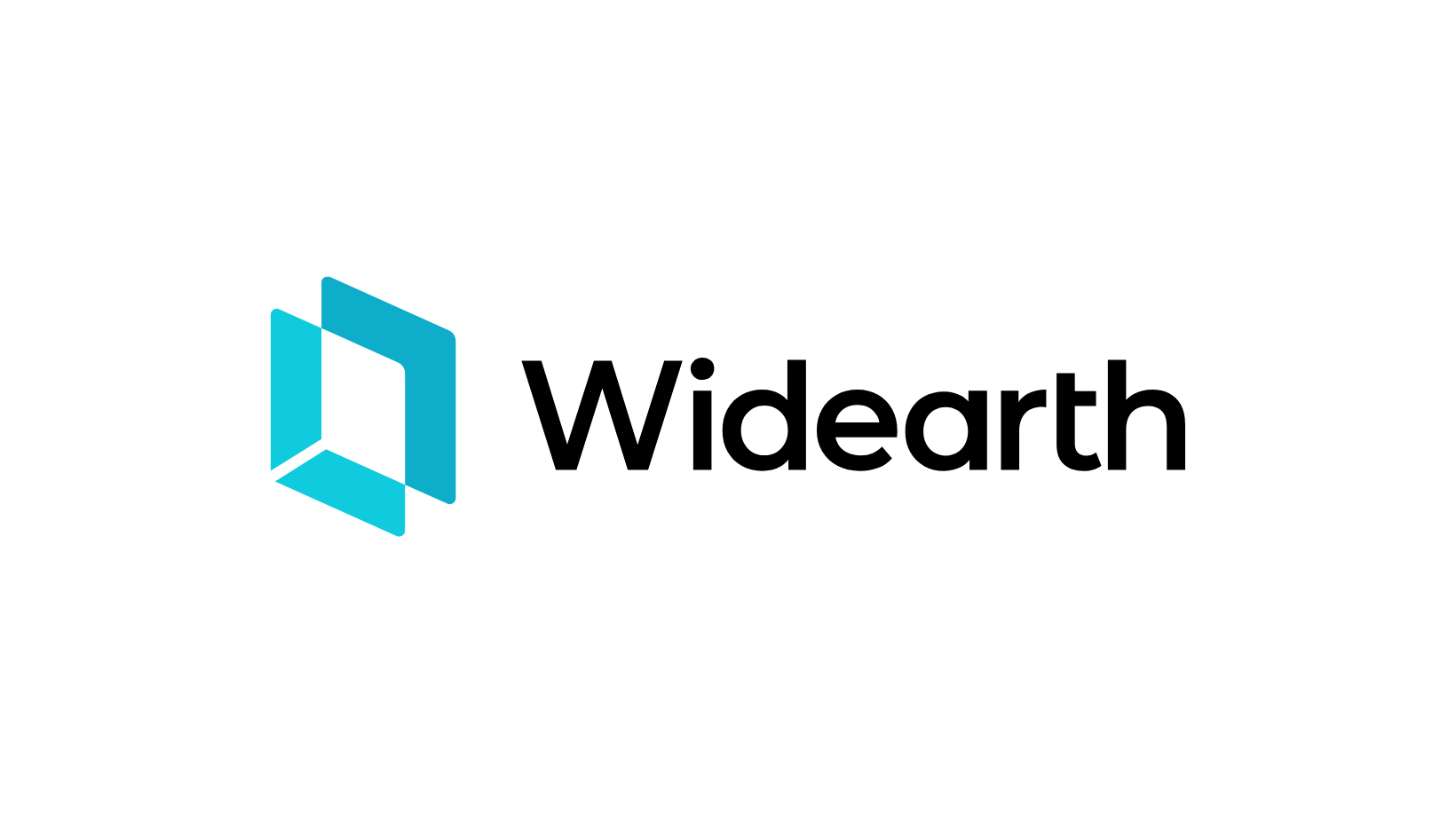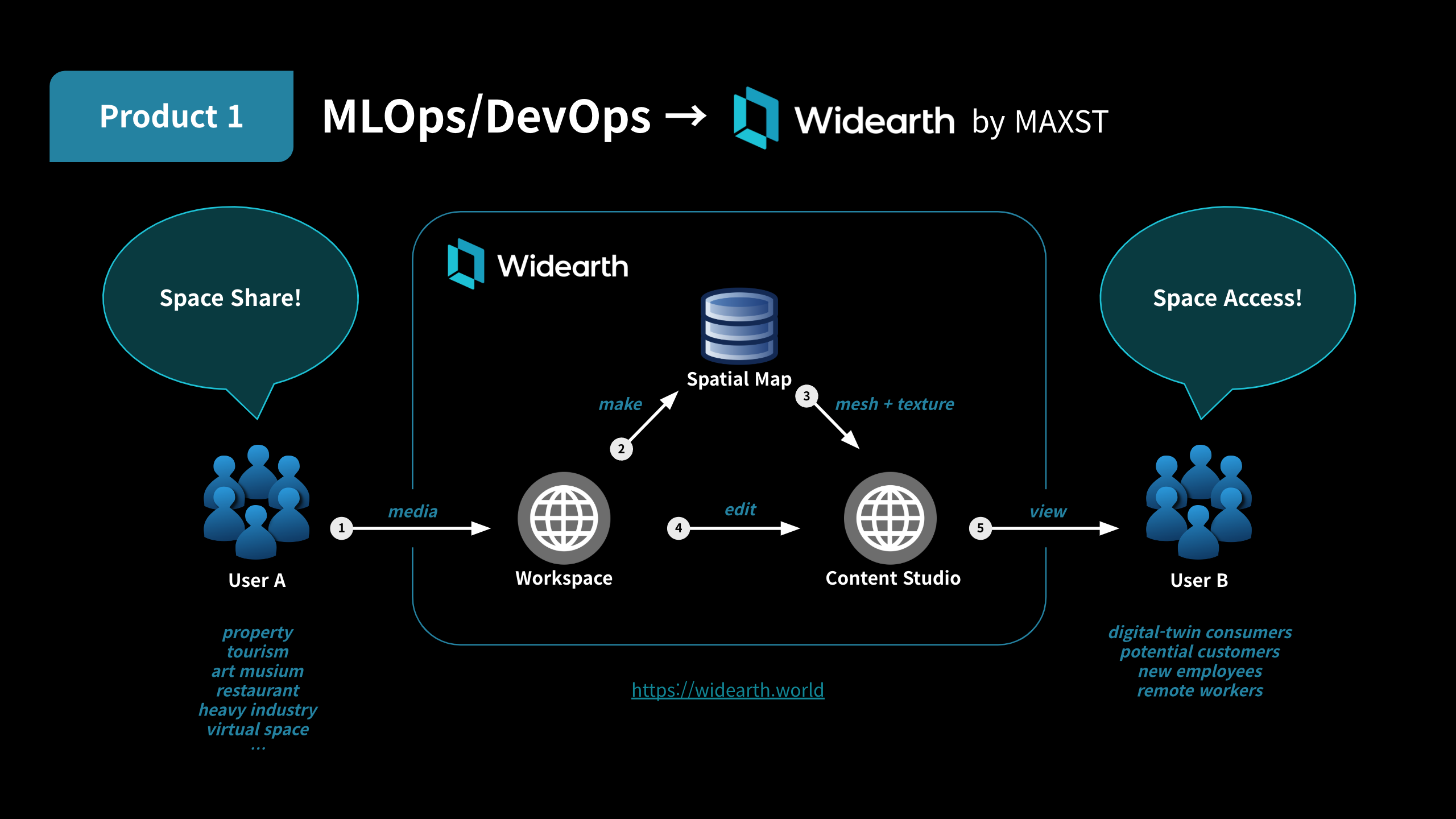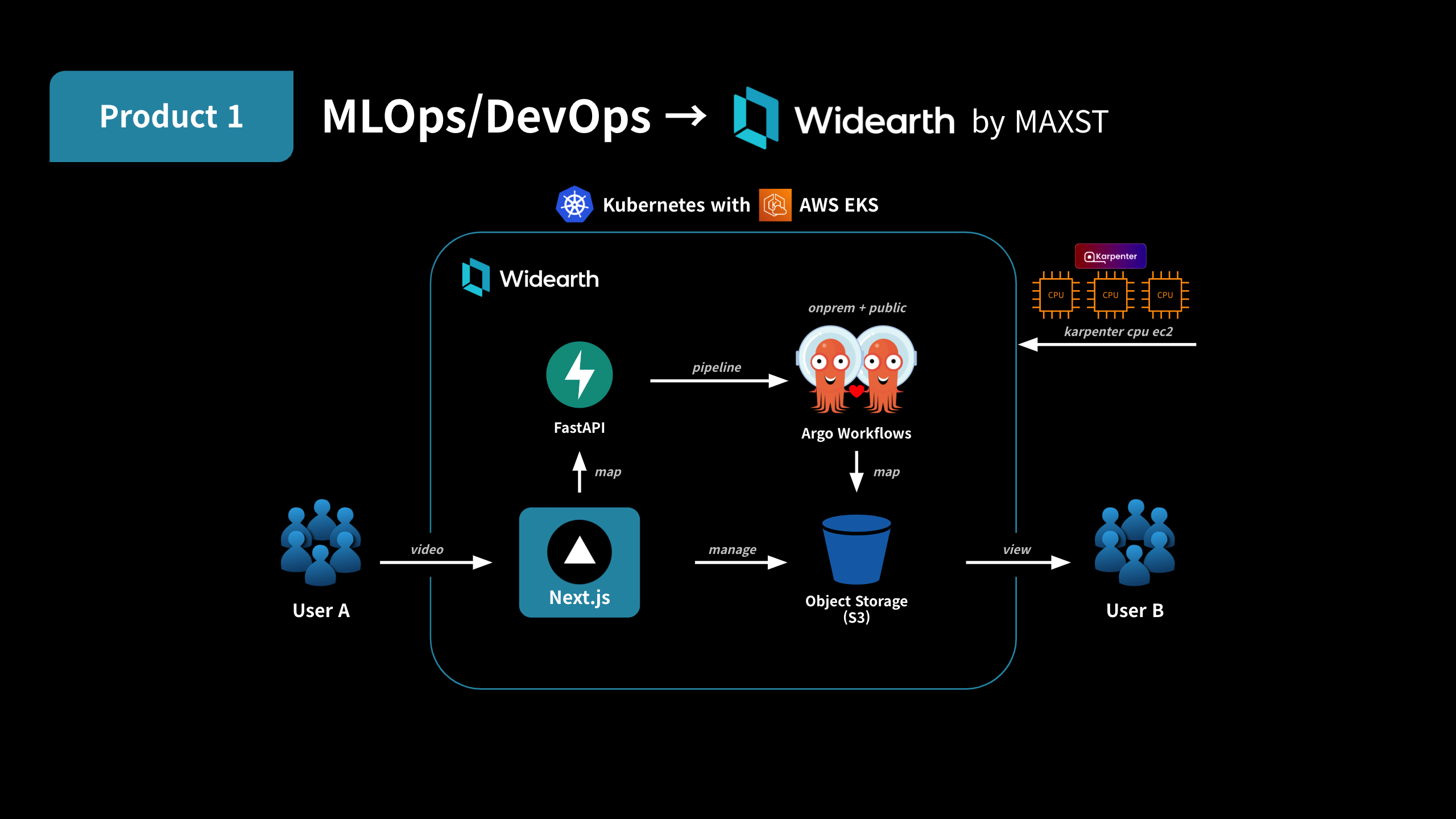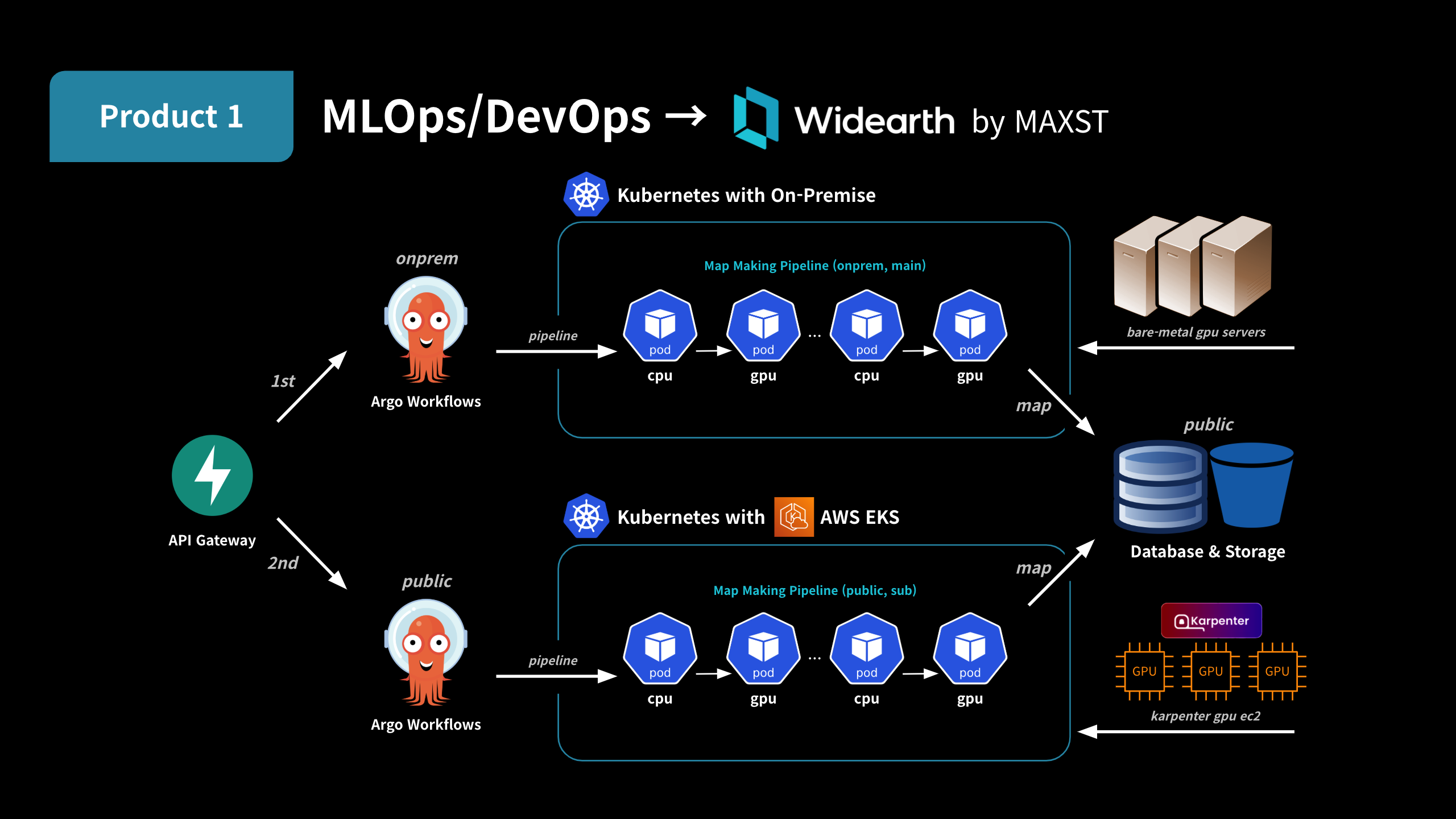Widearth: AR & Digital Twins Platforms at Maxst

A Fully Managed Platform for Real-World Space-Based AR & Digital Twin Services; I contributed to the development of the platform as a lead ML/Infra engineer.
이 문서에 대한 한국어 버전은 이 링크를 참고해주세요.
Summary
- Title: Development of AR & Digital Twin Platform Widearth
- Website: https://widearth.world
- Period: Jan 2024 - Oct 2024 (10 months)
- Role: Lead ML/Infra ~ MLOps/DevOps + ML Backend + SRE [Contribution 75%]
- DevOps & SRE
- IaC, GitOps, CI/CD Pipelines, Monitoring, Logging, Notifications, Multi-Deployment Scenarios, Emergency Calls
- Hybrid Clusters
- AWS EKS + Bare Metal Kubernetes, API Gateway Pattern, Dynamic Instance Management, GPU Cost Optimization
- ML Workloads
- ML APIs, ML Pipelines, Data lake, Dockerizing, Model CI/CD
- DevOps & SRE
- Results: Successful service launch ~ Small Team, All Features Implemented, Improved Availability, Cost Savings
- Service Launch
- 15 people total, 8 developers, 1 infrastructure manager participated in planning and development to contribute to the launch and operation of the platform
- High-Efficiency ML
- Real-time execution of ML pipelines in the on-premises infrastructure of the hybrid cluster. Produced more than 300 space maps in the production environment, and saved about 150M KRW (70%) compared to the previous service
- High-Availability Infrastructure
- Hybrid cluster and disaster response to implement a service with 96% annual availability and a downtime of 14 days
- Service Launch
- Skills
- AWS EKS
- Kubespray
- Python/FastAPI
- Argo Workflows
- Argo CD
- Bitbucket Pipelines
- Karpenter
Details
We configured a hybrid architecture for the digital twin platform.
Please refer to the omitted/simplified parts due to internal security regulations.
 Widearth’s operation flow and user behavior patterns
Widearth’s operation flow and user behavior patterns
Widearth is a B2B2C business that uses digital twin technology to create space maps for the following two users. It is a platform business that provides services to general consumers after passing through the main customers.
- Description of users
- User A (Digital twin content provider)
- User A can create a space map (2) by using the workspace (1) they own.
- The created space map is stored in the cloud and User A can share it through the content studio (3). The shared target is User B (digital twin content consumer).
- User A can also modify the content (4), add content, and process personal information for privacy.
- The candidate group of User A is ‘a subject that makes a profit by sharing space through communication’, and examples are as follows:
- Real Estate / Travel / Art Museum / Restaurant / Heavy Industry / Virtual Space / Disabled-Friendly Facilities
- Their plans are ‘to meet the needs of customers when they are not on site’.
- Before visiting the site / After visiting the site / When it is not possible to visit the site / When the site has changed
- User B (Digital twin content consumer)
- User B is the subject that consumes the space map service provided by User A.
- The candidate group of User B is ‘a subject that makes a profit by consuming space through communication’, and examples are as follows:
- Potential Real Estate Consumer / Potential Traveler / Potential Art Museum Visitor / Potential Restaurant Customer / Potential Employee / Virtual Space User / Disabled Person And Helper/Protector
- They are customers who can get information about the space and use the service from User A by paying for it.
- User A (Digital twin content provider)
 Widearth’s architecture corresponding to the public cloud area. The area where users interact
Widearth’s architecture corresponding to the public cloud area. The area where users interact
- The area where users interact, mainly the public cloud area of the platform.
- It is configured with an MSA (microservice architecture or mini-service architecture) that separates FE/BE/pipeline. Since the databases of each service are not strictly divided, it is appropriate to call it a ‘mini-service architecture’.
- It can operate in single/multi-cluster and all servers are designed to be horizontally scalable according to usage/usage environment.
- The pipeline is explained in detail in the hybrid architecture below.
 Widearth’s architecture corresponding to the hybrid cloud (pipeline). The area where users interact
Widearth’s architecture corresponding to the hybrid cloud (pipeline). The area where users interact
- The area where the pipeline is operating, using both on-premises and public cloud.
- The pipeline is configured with the same specifications on both the on-premises and public cloud. To do this, a ‘file storage’ and an ‘object storage’ are configured in each cloud.
- The database for logging and metadata for the back office is configured only in the public cloud for availability and management.
- The pipeline is allocated to the available area of the on-premises data center first. If the on-premises does not respond or all areas are allocated, it is allocated to the public cloud second and the pipeline is activated.
- If there is an outage/disaster in the on-premises data center,
- If the request exceeds the available capacity of the on-premises data center.
- The public cloud is allocated to the cluster that services FE/BE with the minimum resource allocation for the pipeline. If the pipeline is allocated to the public cloud, the node is allocated and activated.
Through this hybrid architecture, we can operate a platform with high performance, high efficiency, and high availability.